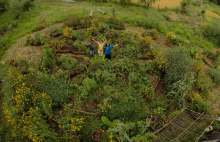Why save seeds?
For thousands of years, it was the norm for growers to save their own seeds. As they saved, grew and saved again, plants adapted to local conditions, and this led to huge diversity all over the world. Then came F1 hybrid seeds, popularised by fertiliser companies in the early 1900s.
These produce more uniform crops, and can be bred to suit machine harvesting, and a longer shelf-life. Good for mass production, but maybe not for you. Small growers may be more interested in taste, adaptability, and a good yield over a longer period. Shockingly, it is estimated that since the early 1900s around 75% of agricultural genetic diversity worldwide has been lost due to commercialised seed.
There is a growing movement to reclaim the skill of seed saving, to rebuild diversity and resilience in local food systems.
Getting started with beans
You can save seeds from all sorts of plants including trees and flowers, but here we are focusing on vegetables, and beans are some of the easiest seeds to save.
The plants need to grow to maturity in order to create seeds. If you aren’t already growing any beans, you can find some useful advice on the Vegan Organic Network website.
If you’re starting from scratch, you can either buy seeds or ask a green-fingered friend if they have any non-hybrid seeds to share. Certain bean and pea varieties, such as Aquadulce broad beans, are good to plant in Autumn, and will grow to maturity over winter allowing you to save seeds in the Spring.
If you buy, we recommend organic non-hybrid seeds from the Best Buys in our Seeds guide,4 such as the Seed Cooperative (formerly Stormy Hall), Real Seeds or Tamar Organics. You could also try your local garden centre.
How to save bean seeds
All you need to do to is leave some of the best-looking pods on the plant until they dry, go brown, and the seeds rattle inside. Then open the pods, pop out the seeds and leave them laid out to dry further in a warm, airy (but not sunny) place. A couple of weeks later, put them in a paper bag or envelope, label it and store in a jar, to use within three years.
For instructions on other vegetables, and a bit more detail, there are many guides online, such as:
Find a seed swap near you
Once you start saving seeds, you will probably find you have more than you need, but only a few varieties. Seed swapping, therefore, offers a great opportunity to acquire some different varieties, as well as meeting other seed savers. Seed swaps often happen in early Spring, and there may be a group near you (see our directory),4 or you could form a new group.
Heritage seeds
You could even become a Seed Guardian for, or just a regular user of, the Heritage Seed Library. Seed Guardians help to conserve vegetable varieties that are not widely available. Membership is through Garden Organic, and costs from £3.75 a month. You get a magazine and newsletter, discounts, and 6 free packets of heritage seeds a year, of your choice from the catalogue which comes out in December.
Are you a food producer?
The Gaia Foundation, along with the Soil Association, Landworkers’ Alliance and others, are now running a UK and Ireland Seed Sovereignty Programme.
This involves regional training courses run by experts for producers who are interested in seed saving, setting up seed circles and raising awareness, running vegetable trials, and then supporting producers who are interested in supplying seed to seed businesses (Real Seeds in Wales and The Seed Co-operative in Lincolnshire), or going further into plant breeding.






